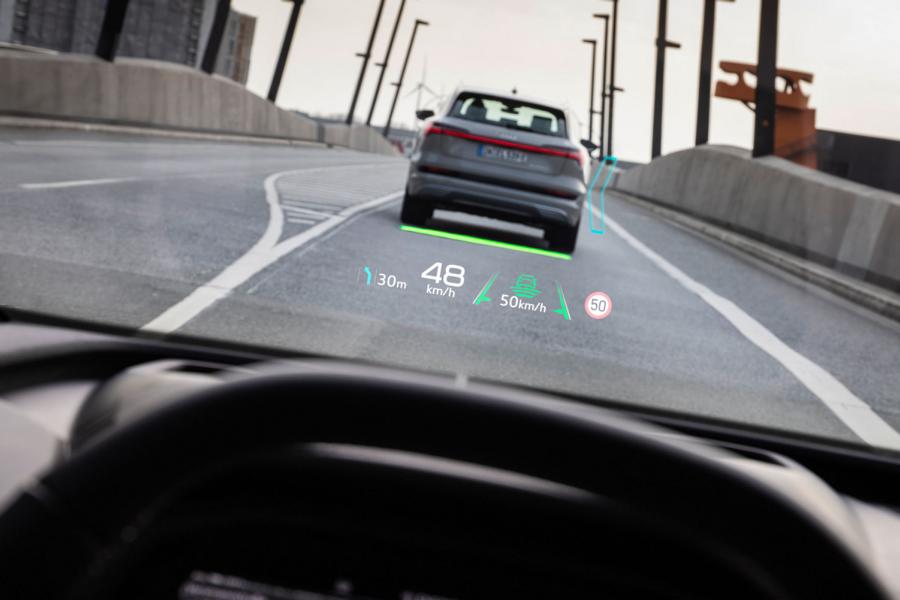Recently updated on October 4, 2021 at 09:28 am
Augmented Reality head-up display
this article passes different Pages
With the optional augmented reality head-up display in the Q4 e-tron and Q4 Sportback e-tron Audi is taking a big step in display technology. It places important information on the windshield in two separate levels - the status area and the augmented reality (AR) area. The information from some assistance systems, the turn-off arrows in the navigation system and their starting and destination points are visually placed over the real outside world and displayed dynamically as the content of the AR area at the right place in each case. They appear to be floating virtually at a distance of around 10 meters from the driver; depending on the situation, they sometimes appear to be significantly further in front of him. The displays can be grasped at lightning speed without irritating or distracting the driver - they are a great help, especially in poor visibility.
From the driver's perspective, the field of view for the AR content corresponds to a diagonal of around 70 inches. Below it is a flat close-range window, the so-called status area. It shows the driving speed, the traffic signs as well as the assistance and navigation symbols as static displays. You seem to be floating about three meters in front of the driver.
The heart of the system: the Picture Generation Unit
The technical heart of the augmented reality head-up display is the picture generation unit (PGU), which is located deep inside the long instrument panel. A particularly bright LC display sends the light beams generated by the PGU onto two flat mirrors, special optics separate the components for the near and far range from one another. The flat mirrors direct the rays onto a large concave mirror with electrical adjustment. From there, they reach the windshield, which reflects them into the so-called eyebox and directs them towards the driver's eyes. At an apparent distance of 10 meters or even more depending on the situation, he sees the symbols just as clearly as the real environment.
Forward-looking imager: the AR creator
The so-called AR Creator - a processing unit in the modular infotainment kit (MIB 3) that is composed of several individual modules - serves as the software mastermind and image generator. The AR-Creator renders the display symbols every 60 frames per second and adapts them to the geometry of the projection optics. At the same time, it calculates its position to match the surroundings - which it uses the raw data from the front camera, the radar sensor and the GPS navigation to find out about. Its software contains around 600.000 lines of programming code, around half more than the entire control system for the first version of the space shuttle.
In its calculation work, the AR Creator takes into account that there are always a few fractions of a second between the detection of an object by the sensors and the output of the graphic content. In these short time frames, the Q4 e-tron change its position significantly, be it through braking or a pothole. Several arithmetic operations run continuously so that the display in the eyebox does not skip. One of them takes place in the software of the camera, with another, the AR Creator predictively calculates how the car will continue to move forward on the basis of the latest data. In a further arithmetic operation, he estimates the vertical movement - the data for this are provided by the camera, radar and the sensors of the stabilization control (ESC). These findings flow into the "Shake Compensation", which takes place a few milliseconds before the image is displayed and has the task of preventing the display from shaking.
Navigation: The drone flies ahead
When it comes to navigation, the augmented reality head-up display shows its strengths particularly impressively. On the road, the so-called drone - a floating arrow - shows the next action point on the route. It behaves dynamically: before an intersection, for example, the floating arrow first announces the turning maneuver, before an animated arrow points precisely into the street. If you then continue straight ahead, the drone flies ahead and disappears, only to reappear in time for the next action point. The distance to the turning point can be seen in meters in the lower window of the close-up area.
Even if the driver has activated the adaptive driver assistant, which guides the car in the middle of the lane, the augmented reality head-up display supports him with visual information. As soon as the Q4 e-tron approaches a boundary line without flashing, the lane departure warning superimposes the real lane marking with a red line. Another example is the control of a vehicle in front: If it is active, the car is marked with a colored stripe on the display - this allows the driver to see the status of the Adaptive Driving Assistant or the Adaptive Speed Assistant without distraction. A red marking and a warning symbol appear when the adaptive driving assistant asks the driver to demonstrate that he is paying attention.
 tuningblog.eu Your magazine about tuning the car
tuningblog.eu Your magazine about tuning the car
